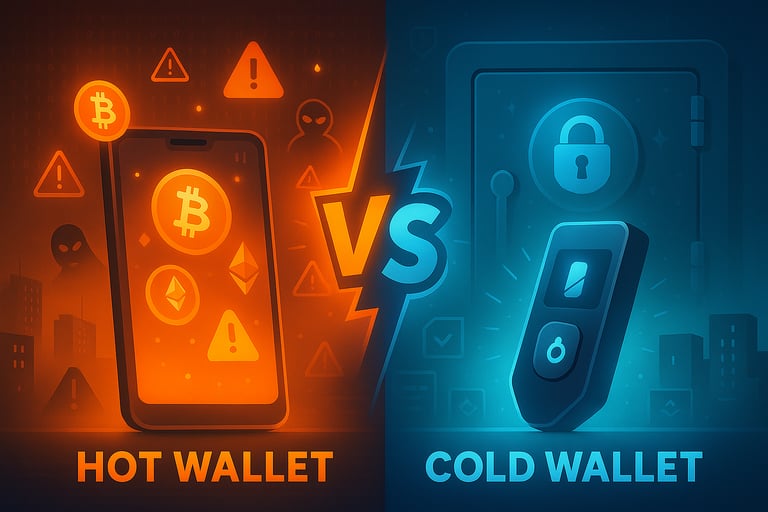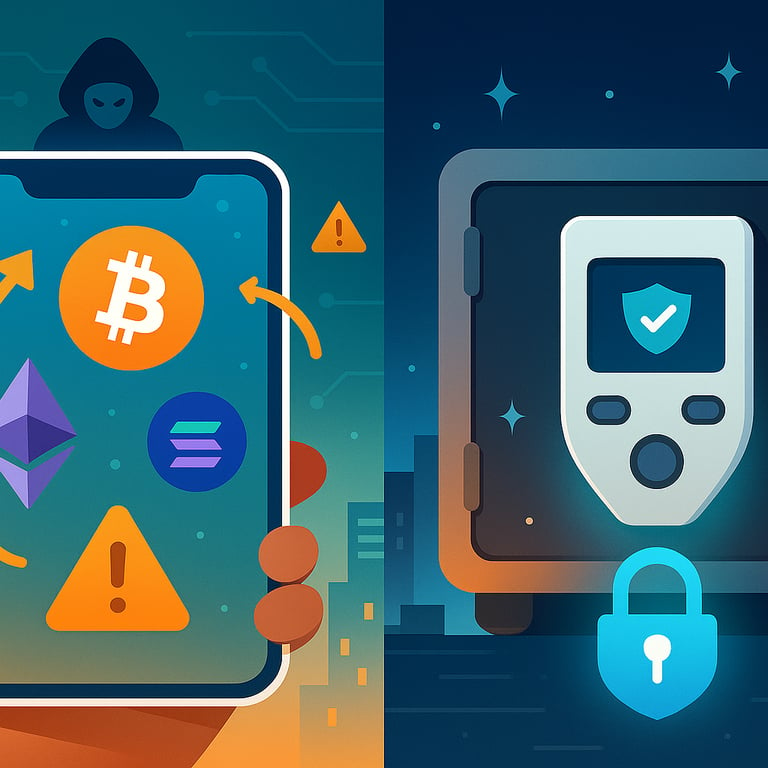Hot vs Cold Crypto Wallets: Which Is Safer in 2025?
Hot vs cold wallets: compare convenience, security, cost, and best practices. Discover how to bulletproof your crypto storage with expert tips and hybrid strategies. #hot vs cold crypto wallets
Chain Editorial Team
6/12/20256 min read
💭 Imagine This…
It's 2 AM, and your screen lights up as a memecoin moons unexpectedly.
You jump, launch MetaMask, and execute a lightning-fast trade, thrilled and exhilarated. But as you celebrate, a hidden script embedded in the extension silently siphons your tokens. By sunrise, your balance has vanished.
Contrast that with the next morning: you quietly retrieve your Ledger from a locked safe. Calm, untouched, and secure, your funds are exactly where you left them, frozen in silent protection.
That stark juxtaposition, adrenaline-fueled speed versus rock-solid security, captures the real trade-off between hot and cold wallets.
⚡ FlashChain: Your 15s Brief
Hot wallets: online, ultra‑convenient, great for DeFi or trading, but exposed to hacks.
Cold wallets: offer offline, fortress-level security, ideal for long-term storage, although they are pricier and slower. Don't forget you are the bank!
Best strategy: Hybrid hot for quick spends, cold for serious stash.
Security first: Always buy legit hardware, backup seed words, update firmware, and segregate use cases.


💡 Let’s Dive In
What Is a Hot Wallet?
Hot wallets are software-based, always-online tools, mobile apps, browser extensions, or desktop programs. They store your private keys on an internet-connected device, enabling lightning-fast access to DeFi, DEXs, and token swaps, but also exposing your keys to malware and phishing.
Popular hot wallets: MetaMask, Coinbase Wallet, Trust Wallet, Exodus, Electrum.
Why people choose them:
No-cost setup
Plug-and-play simplicity
Perfect for regular use, send, stake, trade
Downside:
Always online = always vulnerable
Hackers exploit device/software flaws
You must trust your environment and provider
What Is a Cold Wallet?
Cold wallets are offline guardians for your crypto, hardware devices, paper backups, or air-gapped machines. By isolating private keys from the internet, they build a digital moat against hackers.
Popular cold wallets: Ledger Nano X/Stax, Trezor, CoolWallet, Ellipal, KeepKey .
Why they’re trusted:
Secure elements & PIN safeguards
Most haven’t been compromised, and there is a nearly zero breach rate when used correctly.
Ideal for sizable holdings
Trade-offs:
Upfront cost ($50–$200+)
Slower transactions, must connect to a hot wallet or QR
Physical vulnerabilities: loss, breakage, forgotten PIN
You are the bank and security.
Custodial vs Non-Custodial
Non-custodial: You control your keys (hot or cold). Full responsibility, full control.
Custodial: Third-party holds keys (like exchanges). Easier, but you're trusting them completely, and risk losing assets in hacks or insolvency.
🧾 Final Take
Are you trading daily or using DeFi? Hot wallets are essential, but limit your balance.
HODLing a substantial portfolio? Cold wallets offer vault‑grade protection.
Balance is key: freestyle with hot, fortress with cold.
Crypto storage isn’t just tech, it’s strategy. Deploy thoughtfully.
🔔 Stay Plugged Into the Chain
Don’t just read the future — ride it.
Join crypto-curious minds who are already unlocking insights with us.
📬 Subscribe to our newsletter for weekly alpha, real-world strategies.
📱 Follow us on Instagram and X for bite-sized insights, memes, and market signals that actually make sense.
👉 Your journey through the chain starts here.
🛡️ Best Practices to Bulletproof Your Setup
🔐 1. 🔒 Choose Legit Hardware & Keep Firmware Current
Always buy hardware wallets directly from manufacturers, never from resellers or dubious third-party sites, to avoid hidden malware or tampering.
Once you have your device (like Ledger or Trezor), immediately set a PIN, generate a seed phrase offline, and update firmware using official tools; outdated software is a hacker's playground.
🔏 2. Ultra-Secure Seed Phrase Handling
Write your recovery words offline, preferably on fireproof metal plates (e.g., Cryptosteel, SecuX XSEED Pro), not paper or digital files.
Never store your seed on any internet-connected device, including phones, photos, or cloud services.
Keep multiple backups in separate locations: home safe, a trusted relative’s safe, or an anonymous bank deposit box, so a fire or burglary won’t destroy all copies.
Add passphrase bonus security by using an extra 13th/25th word.
Just remember: lose the passphrase, lose the funds.
🤝 3. Consider Multisig for Maximum Protection
Sophisticated setups may use 2-of-3 multisig across multiple hardware wallets from different brands, stored in different places.
This way, no single device or seed compromise can drain your funds.
🧪 4. Test Transactions for Peace of Mind
When sending funds to a new cold wallet, always perform a small test transfer first.
Verify the receiving address on the wallet's screen; you can’t trust clipboard copying, which malware might manipulate.
Once confirmed, consolidate everything in one precise transfer to avoid leftover dust and reduce risk.
🔄 5. Safeguard Your Hot Wallet Usage
Keep only minimal funds in your hot wallet for daily use; stash the rest in cold storage.
Use unique, complex passwords and manage them via a password manager like Bitwarden or LastPass.
Enable app-based 2FA (Authy, Google Authenticator), never rely on SMS.
Regularly update your wallet software, browser extensions, antivirus, and OS to patch vulnerabilities.
Verify URLs and only use trusted sources when interacting with DeFi sites or block explorers. Phishing scams are a common hot-wallet exploit .
Avoid public or unsecured Wi-Fi. If need be, use a VPN to help reduce network-level threats.
🏠 6. Physical Security for Cold Wallets
Store hardware wallets in a fireproof, waterproof safe, and ideally bury or anchor them so they can’t be casually taken.
Rotate backup locations: one at home, one off‑site (e.g., trusted friend’s house or safe deposit box).
Handle with intent: cold wallets are entry points, limit access, unplug when not in use, don’t expose PINs, and always keep a clean environment during setup.
🧩 7. Practice & Prep for Emergencies
Conduct seed recovery drills: once in a while, simulate a loss and restore your wallet using backups. That ensures you won’t be stranded when it matters.
Build an inheritance plan: ensure trusted individuals know how to locate/discover backups, but split info to avoid easy theft.
Document wallet structure and passphrase usage securely, without exposing sensitive info, to ensure continuity.
✅ Summary – Your Security Playbook
Legit hardware + firmware updates
Offline seed phrase storage (ideally metal)
Multisig with distributed devices & locations
Test small TX ➜ big TX
Minimal hot-wallet balance, strong passwords & 2FA, secure browsing
Fortified physical safes, off-site redundancy
Emergency testing + inheritance-ready setup
By applying these layered safeguards, you build a defense architecture that addresses both digital and physical threats, turning your crypto into a fortress.
Real‑World Hacks That Wake You Up
Bybit Feb 2025: $1.5B stolen from a “cold” wallet, hackers exploited offline transfer vectors.
“According to Business Insider, around 401,000 ETH (~$1.5 billion) was stolen during a routine cold‑to‑warm wallet transfer in February 2025, after attackers manipulated the signing interface.”
👉(source: Business Insider, FT)WazirX July 2024: $234M drained by manipulating a cold-wallet multisig flow.
“In July 2024, WazirX lost approximately $234.9 million after a Lazarus-linked exploit in its multisig cold wallet allowed attackers to upgrade the smart contract and drain funds.”
👉source: Business Insider, WikipediaCrypto crime in 2025: Over $500M stolen in first half; 63% via hacking/phishing, hot wallets are front-line targets.
“Wikipedia reports over $502 million stolen in early 2025, with 63% due to hacks and phishing, highlighting hot wallets as the main exposure vector.”
👉Wikipedia
The Hybrid Strategy Wins
Think of it like banking: use a hot wallet like a checking account, fast, handy, and low balance.
Use a cold wallet like a safety deposit vault, for serious funds you don’t plan to touch. That combo gives you speed and security, without compromise.



Subscribe to our newsletter
CIN - ChainInsights Net
Crypto Education & Legacy Platform.
Explore crypto finance, trends, and market strategies.
© 2025 ChainInsights Net. All rights reserved.
⚠️ Disclaimer
Everything you see on ChainInsights.net — including blog posts, tools, links, community content, and socials — is shared for general educational purposes only. We source insights from multiple third-party platforms, but we don’t guarantee the accuracy, completeness, or freshness of the information.
Nothing here is financial, legal, or investment advice. You shouldn’t make decisions based solely on our content. Always do your own deep-dive, triple-check your sources, and consult a qualified financial advisor before putting capital on the line.
Crypto is risky, and markets move fast. Your choices are yours alone — we’re just here to decode the noise, not direct your trades.
❤️ Fuel the Mission
Every world-changing idea starts with someone who believes.
Every movement begins with one spark, but it takes a community to build the fire.
Your support helps us grow, reduce ads, and stay truly free.
Donations: 0x331381fB8AE4894d8Ee8d1f066C4582B2262ccDA






